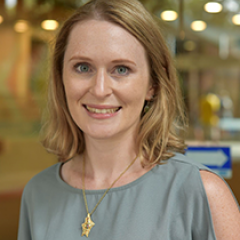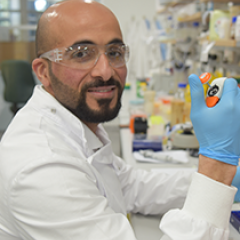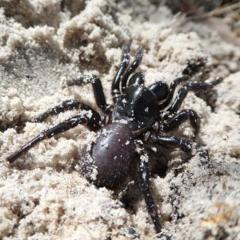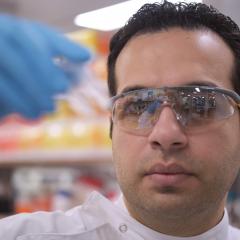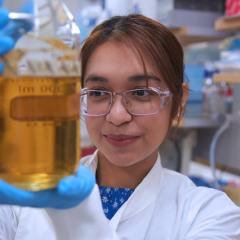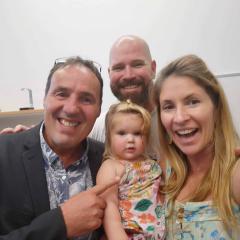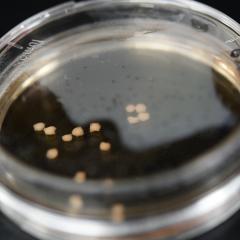Wolvetang Group
Leveraging human induced pluripotent stem cells to create brain and spinal cord organoids with the aim of developing and testing novel therapeutics for genetic, environmental and ageing-related neurological conditions.
The Wolvetang Group, led by Professor Ernst Wolvetang creates brain and spinal cord organoids from human pluripotent stem cells in order to elucidate the genetic, environmental and ageing impacts on human brain development and function, with the aim of developing therapeutics such as small molecule drugs, and gene therapy
Both organoid generation and therapeutics screening are increasingly carried out with the aid of automated high-content imaging robotics.
Research Areas
- Human induced pluripotent stem cells
- Brain and spinal cord organoids
- In-vitro disease models
- Neurotropic viruses
- Hypoxia induced encephalitis
- Epilepsy
- Rare diseases
- Ageing
Research Approach
The group’s strategy is to capture the genomic make-up of an individual by reprogramming patient-derived blood or skin cells into immortal human induced pluripotent stem cells that can make all cell types of the human body (including the brain). CRISPR-enabled manipulation of the genome, epigenome and gene expression in the lentil-sized in-vitro brain and spinal cord organoid models are combined with robotic high-content imaging approaches, single-cell analysis gene expression and functional read-outs on multi-electrode arrays to understand the underlying molecular mechanisms of disease and to screen therapeutics. These approaches continue to provide new insights into the neuropathogenic processes in Down syndrome, Ataxia-Telangiectasia, childhood white matter disease (leukodystrophies, epilepsy and cortical dysplasia, and uniquely enable assessment of the impacts of neurotropic viruses such as ZIKA and SARS-COV2. We also use brain organoid models to design personalised treatments for drug-resistant epilepsy, and for pre-clinical testing of gene therapy and drug treatments for neurodegenerative diseases and ageing-related processes such as senescence.
Research Highlights
Collaborations
Professor Wolvetang leads three MRFF funded missions, 2 ARC DPs, and an NHMRC ideas grant. He collaborates with leading clinical researchers of neurological diseases such as Prof David Coman, Prof Patrick Kwan, Prof Terry O’Brien. Professor Wolvetang further leads a number of industry projects that leverage in-house automation systems, multi-electrode array technology, advanced transcriptome analysis methods, and stem cell derived organoid models for testing of therapeutics. He engages with multiple patient advocacy groups such as GC4K, the Massimo Foundation, and BrAshAT to foster the development of novel therapeutics for hereditary spastic paraplegias, hypo-myelinating diseases, and childhood ataxias.
Research Projects
-
NHMRC 2020 Stem Cell Therapies Mission
January 2021–January 2024 -
Safer gene-editing tools for Australian livestock and biotech industries
March 2021–March 2024 -
Understanding and treating childhood white matter disease
January 2021–January 2024 -
Moon’s Mission: creating a replicable therapeutic framework for hereditary spastic paraplegias
January 2023–January 2025 -
ATM at the crossrads of ageing, neurodegeneration and metabolism
January 2022–January 2025
PhD opportunities
Funding
Since 2019
- MRFF Stem Cell Therapies Mission (2024) Spider venom peptides: precision therapy for genetic epilepsies.
- ARC Discovery Project (2024) Creating a window into the mind
- The Florey Institute of Neuroscience and Mental Health (2023) A brain in a dish: Developing a sophisticated system to test multiple sclerosis treatments, as further described in the Project Plan
- NHMRC IDEAS Grants (2023) A human brain organoid model of acute prenatal hypoxia enables biomarker discovery and drug screening for hypoxic-ischemic encephalopathy.
- NHMRC MRFF Stem Cells Therapies Mission (2023) Moon's Mission: creating a replicable therapeutic framework for hereditary spastic paraplegias.
- University of South Australia (2023) ABOLISH Neuroblastoma (MRFF Childhood Cancer Research Grant led by University of South Australia)
- Preclinical and Clinical Early Career Research (2022) The oligodendrocyte brain organoid models children with leukodystrophy and enables drug screening
- Australian National University (2022) Phenomics Australia national Non-Animal Technologies Service (NATS) at UQ
- ELA International (2022) Deciphering disease heterogeneity: Spatiotemporal analysis of molecular and cellular pathology in HBSL
- University of South Australia (2022) Identification and assessment of new treatment options for the childhood cancer Neuroblastoma (MRFF Stem Cell Therapies led by Uni South Australia)
- The Trustee for Moon Atlas Trust (2021) Hereditary Spastic Paraplegia Research Model
- National Stem Cell Foundation of Australia Matched Funding Program (2021) Repairing catalase function in A-T patients using a CAT-SKL therapeutic
- NHMRC MRFF Stem Cells Therapies Mission (2021) Transforming the paradigm of epilepsy care with precision medicine
- UQ Knowledge Exchange & Translation Fund (2021) Exemplification of new and safer gene editing tools for cultured meat production in Australia
- ARC Discovery Projects (2021) Safer gene editing tools for Australian livestock and biotech industries
- Brain Foundation (2021) 3D brain organoid models of epilepsy patients with cortical dysplasia as personalised medicine platforms
- Murdoch Childrens Research Institute (2019) Leukodystrophy Flagship (MRFF Accelerated Research, administered by Murdoch Children's Research Institute)
Publications
Click here to view Wolvetang group publications


